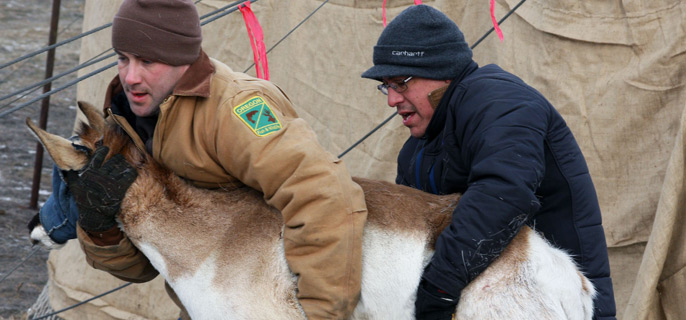
PHOTOS BY HAL MCCUNE
Nearly 40 pronghorn antelope were captured and relocated from the Umatilla Chemical Depot (UMCD) to Malheur County on Tuesday.
Pronghorn were long-time residents of the UMCD and even featured on the facility’s logo. They were originally captured near Brothers, Ore. in 1969 and placed on the Depot to serve as a nursery population for other transplant operations in eastern Oregon. The population on the Depot peaked at more than 350 animals in 1986 and has been used to supplement populations throughout Oregon and in Nevada.
Fencing around the Depot kept them enclosed in the 19,000-acre installation. The original 1962 agreement between UMCD and ODFW called for the pronghorn to be removed if the Depot ever shut down. Adjacent agricultural land and industrial development make the area unsuitable for the pronghorn once Depot fences are removed.
Depot Staff and Locals Recall Pronghorn
“We are going to miss them. We’re all sad about them going,” said Michele Martin, BRAC environmental coordinator at the Depot.
Don Gillis, the former natural resources manager at UMCD, remembers the whole Depot’s affection for the animals. “We all liked to watch them and we would take visitors here out to show them the pronghorn,” said Gillis. “Everyone was always talking about where the pronghorn were, especially the babies.”

Former ODFW Heppner District Biologist Glenn Ward recalled when the pronghorn were first put on the Depot in the late 1960s. At that time, the nearest antelope were near Aldrich Mountain in Grant County. “Everyone was elated to have pronghorn in the area,” Ward said. “Now, we have antelope scattered all over Morrow and Gilliam counties.”
Fish and Wildlife Commission Chair Bobby Levy was raised in Hermiston and now lives in Echo. She said that while the Depot was closed to the public, its pronghorn were often seen from the highway. “We all knew they were there and enjoyed seeing them.”
The Capture Operation
Pronghorn are the fastest ungulates in North America and can reach speeds of up to 40 miles an hour. ODFW used a helicopter to herd the pronghorn into long wing fences and finally a corral trap.
During winter, antelope are even more likely to spend time collectively as a herd, and scouting in the days prior to the operation made them easy to find Tuesday morning. Once the 38 pronghorn remaining on the Depot were in the corral trap, each was individually captured and processed (blood-sampled, disease tested, vaccinated, ear-tagged). Finally, the pronghorn were put in a trailer and driven to the Malheur County for an evening release on public land in the Beulah Wildlife Management Unit.
A total of 37 animals were released in Malheur County (eight adult males, 22 adult females, and seven young). One pronghorn captured was euthanized because of its poor condition.
Pronghorn antelope are native to the Columbia Plateau and the High Desert shrublands of eastern Oregon. Oregon has approximately 25,000 pronghorn antelope and offers about 2,500 hunting tags each year.
Future Plans for Wildlife on the Depot
Carl Scheeler, wildlife program manager, Confederated Tribes of the Umatilla River Indian Reservation is a long-serving member of the Local Reuse Authority (LRA), the community organization that guides redevelopment when bases close. The pronghorn might be leaving, but Scheeler is excited about the area’s potential for wildlife conservation.
“The Depot is a very unique piece of landscape,” he said. “It’s the second largest contiguous tract of shrub steppe habitat left in the Columbia Plateau in Oregon.”
The Depot is home to the largest colony of burrowing owls in the continental U.S., breeding populations of long-billed curlew, and supports many other shrub-steppe dependent species. Sagebrush steppe and shrublands are identified in the Oregon Conservation Strategy as in need of conservation throughout their range.
Long-term plans for the Depot call for a 5,700-acre wildlife refuge. Much of the other property is going to the Oregon National Guard, who will manage the area “in a manner consistent with the protection of shrub steppe values” says Scheeler. Agriculture and commercial development are also planned.
Scheeler continues to work to see that final plans manage the refuge to safeguard its unique landscape. “The Army Depot inadvertently protected one of the most important shrub steppe tracts,” said Scheeler. “Continued efforts to ensure long term conservation of this unique area after the closure of the Depot are critical.”










